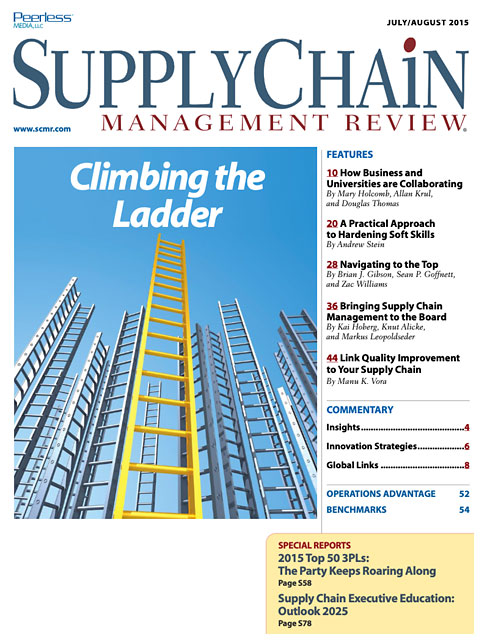Sorry, but your login has failed. Please recheck your login information and resubmit. If your subscription has expired, renew here.
July/August 2015
When it comes to career development, supply chain managers have to execute a bit of jiu jitsu. They’re charged with nding and developing the next generation of talent while simultaneously advancing their own careers in a eld that is often overlooked by senior management. The biggest challenge of all is getting their agenda in front of the Board at a time when supply chain operations are more critical than ever to an organization’s success, but still largely invisible compared to sales, marketing, and product development. Remember: It’s your career—and your supply chain. We hope this month’s issue will help you make the most of both. Browse this issue archive.Need Help? Contact customer service 847-559-7581 More options
From the time most of us take our first job, we’re told to climb the ladder of success if we want to get to the top. In most professions, there is a well-defined set of career rungs that lead to the top. Accountants and lawyers prove themselves as associates, get promoted to partner, and then, perhaps lead their own firms. Sales professionals often begin on the customer service desk before working their way into the field and then up to product managers, district managers, and VPs of sales and marketing. You may not make it all the way to the top of your career ladder, but the path is straight, clear, and understood by all.
That’s not the case for supply chain professionals, where the path to the top is more like climbing a mountain. There is typically no single straight route to the peak. Instead, a climber can pick their way up any number of routes, with the speed and path of ascent based on the climber’s skills, interests, and tolerance for risk. Like a mountain climber, supply chain professionals
must work around obstacles—sometimes moving sideways and even backwards—to advance their careers.
Of course, few mountain climbers or supply chain professionals make it to the top on their own. Just as the mountain climber needs ropes, harnesses, and crampons, the supply chain professional must use technology tools, process knowledge, and people skills to advance. It also helps to work with a climbing guide—or mentor—who has already scaled their own peak and understands the terrain, monitors progress, and applies the brake when necessary.
 |
This complete article is available to subscribers
only. Click on Log In Now at the top of this article for full access. Or, Start your PLUS+ subscription for instant access. |
SC
MR
Sorry, but your login has failed. Please recheck your login information and resubmit. If your subscription has expired, renew here.
July/August 2015
When it comes to career development, supply chain managers have to execute a bit of jiu jitsu. They’re charged with nding and developing the next generation of talent while simultaneously advancing their own careers… Browse this issue archive. Access your online digital edition. Download a PDF file of the July/August 2015 issue.
 |
Download Article PDF |
From the time most of us take our first job, we're told to climb the ladder of success if we want to get to the top. In most professions, there is a well-defined set of career rungs that lead to the top. Accountants and lawyers prove themselves as associates, get promoted to partner, and then, perhaps lead their own firms. Sales professionals often begin on the customer service desk before working their way into the field and then up to product managers, district managers, and VPs of sales and marketing. You may not make it all the way to the top of your career ladder, but the path is straight, clear, and understood by all.
That's not the case for supply chain professionals, where the path to the top is more like climbing a mountain. There is typically no single straight route to the peak. Instead, a climber can pick their way up any number of routes, with the speed and path of ascent based on the climber's skills, interests, and tolerance for risk. Like a mountain climber, supply chain professionals
must work around obstacles—sometimes moving sideways and even backwards—to advance their careers.
Of course, few mountain climbers or supply chain professionals make it to the top on their own. Just as the mountain climber needs ropes, harnesses, and crampons, the supply chain professional must use technology tools, process knowledge, and people skills to advance. It also helps to work with a climbing guide—or mentor—who has already scaled their own peak and understands the terrain, monitors progress, and applies the brake when necessary.
 |
SUBSCRIBERS: Click here to download PDF of the full article. |
SC
MR

Latest Supply Chain News
- Retail sales see gains in October, reports Commerce and NRF
- Balancing green and speed: Home delivery insights from the pandemic era
- AdventHealth named top healthcare supply chain by Gartner
- Geopolitical readiness in supply chains: Strategic challenges for leaders
- Unlocking retention: The role employee engagement plays
- More News
Latest Podcast

 Explore
Explore
Topics
Latest Supply Chain News
- Retail sales see gains in October, reports Commerce and NRF
- Balancing green and speed: Home delivery insights from the pandemic era
- AdventHealth named top healthcare supply chain by Gartner
- Geopolitical readiness in supply chains: Strategic challenges for leaders
- Unlocking retention: The role employee engagement plays
- Can supply chain managers embrace an entrepreneurial mindset?
- More latest news
Latest Resources

Subscribe

Supply Chain Management Review delivers the best industry content.

Editors’ Picks





